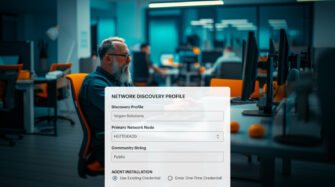Why It’s Time MSPs Rethink IT Management
There was a time when managing IT felt straightforward. Networks lived on-premises, devices were company-issued, and data stayed behind the firewall.
For MSPs, that meant success was possible with just a few trusted tools, some PowerShell skills, and a solid helpdesk system.
Fast forward to today.
Remote and hybrid work are the norm. Clients rely on a sprawling mix of cloud applications, some you may not even know they’ve adopted. Microsoft’s ecosystem alone has expanded to include Microsoft 365, Azure, Defender, Intune, Entra ID, and more.
At times, it can feel like you’re managing not only IT but the digital backbone of your clients’ entire operations. And in a way, you are. Security, compliance, identity, device, and app management, across multiple environments, all fall under your purview. The modern MSP wears many hats, often at once.
We are deep in the age of complexity. But rather than being overwhelmed, let’s look at this shift as an opportunity to evolve MSP service delivery, streamline operations, and deepen client relationships.
The Gist: The Problem Isn’t Just Complexity — It’s Fragmentation
Complexity in IT isn’t the core problem. MSPs have always dealt with and been great at solving complex challenges.
What’s changed is how MSPs are being asked to solve them. Most providers are doing so using a patchwork of disconnected tools and workflows that were never designed to work together.
The result? More effort, less visibility, and rising pressure to deliver consistent, scalable service.
This isn’t merely a bigger workload; it’s a different kind of work, and therefore, it demands a different kind of approach: multi-tenant IT management.
3 Reasons the Legacy Model Doesn’t Work for Today’s MSPs
Let’s be honest: traditional IT management models weren’t designed for the multi-tenant, cloud-first world we operate in now. They were built for a different era.
Today’s MSPs are managing modern environments that are overwhelmingly Microsoft-based, and for good reason. Microsoft’s tools are powerful, flexible, and business-critical. But managing them across tenants? That’s where the friction begins.
Below, we explore three main reasons why the IT management approach of yesterday doesn’t work for today’s MSPs.
1. Silos Lead to Blind Spots
Each Microsoft tenant comes with its own admin center, its own policies, and its own quirks. To manage them, MSPs must oscillate between M365 Admin, Intune, Azure, Defender, Exchange, SharePoint, PowerShell…and then back again.
It’s a cycle that eats up time, increases the risk of making errors, and leaves you stuck reacting instead of proactively protecting.
Even answering basic, business-critical questions like the ones below becomes, at best, difficult and at worst, impossible:
- Who has global admin rights across all tenants?
- Are MFA policies consistently enforced?
- Where are the risky logins or misconfigurations?
The impact of these silos include reduced visibility, inconsistent security, and slower incident response, costing organizations billions of dollars each year.
Businesses are becoming more aware of the risk and increasing their investment in bolstering their security posture. It’s a start, but to truly eliminate these blind spots, MSPs must also invest in tools that give them unified visibility into the many IT environments they manage.
2. Manual Doesn’t Scale
MSPs are masters of process. From user onboarding and ticket handling to billing and monthly reporting, they’ve built playbooks, workflows, and standard operating procedures to keep client environments running smoothly.
But when those processes rely on manually configuring policies or assigning licenses tenant by tenant, things quickly become unsustainable.
Some MSPs attempt to mitigate this issue by automating with PowerShell, which can certainly help — that is, until a script breaks, behaves unpredictably in varied environments, or only lives in one technician’s OneDrive, etc.
Manual processes don’t scale. What works for one client becomes unmanageable when your client base reaches double digits. And every repetitive task pulls time away from higher-value work.
This is especially problematic given the pace of digital transformation worldwide. In fact, the global digital transformation market is expected to more than double from $469.8 billion in 2020 to over $1 trillion by 2025, a clear indicator that IT services are evolving fast and demanding scalable operations.
Repeatable automation isn’t a “nice to have” anymore. It’s the only way to meet client expectations, deliver consistent outcomes, and grow sustainably without burning out your team.
3. Reactivity Costs You
No one likes firefighting. MSPs don’t — and your clients don’t either.
You need to know the moment something is amiss, whether it’s when security configurations drift, endpoints fall out of compliance, or something else. But traditional IT management models weren’t designed for this level of real-time, cross-environment awareness. Alerts are scattered across systems, dashboards don’t talk to each other, and context is often missing entirely.
The point is that without real-time, multi-tenant insights, you’re left reacting to issues after the damage is done. This reality often costs you time, money, and, unfortunately, customer trust.
The New Model: A Platform-First Approach
A modern approach to IT management isn’t about adding another tool to your stack. It’s about rethinking the foundation of your stack and anchoring it around a platform purpose-built for multi-tenant IT management.
Imagine this:
- A single dashboard that shows Secure Score, MFA status, license usage, compliance posture, and admin roles — across all your tenants.
- Prebuilt workflows for onboarding, offboarding, and license assignments that apply consistently by role or group.
- One-click actions that standardize security settings across your client base.
- Reports that write themselves: license optimization summaries, compliance overviews, and security posture comparisons that make your value crystal clear.
This is what top-performing MSPs are striving for today, if only they had access to the right tooling to support multi-tenant IT management.
Future-Ready MSPs Operate Differently
With the global managed services market expected to grow by over $100 billion between 2020 and 2025, the shift toward outsourced IT operations is gaining serious momentum. MSPs that invest in scalable, modern solutions today are positioning themselves to capture that demand and to differentiate themselves in an increasingly crowded market.
MSPs who modernize their stack now are doing more than keeping up — they’re shaping the future of IT services.
Share














